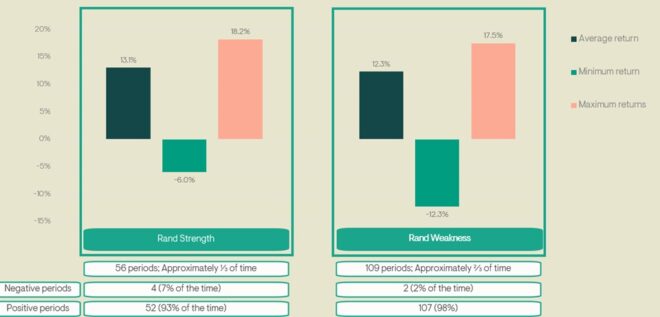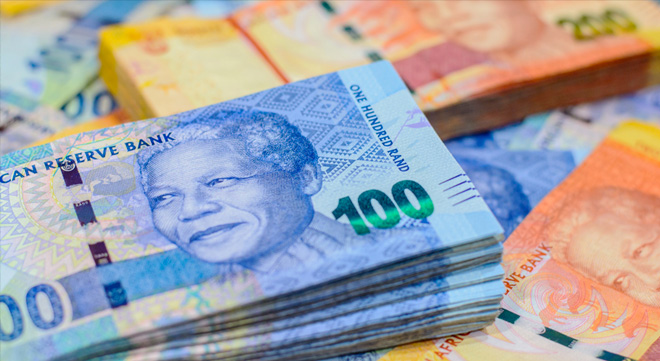Investors accept there are compelling reasons for investing offshore: diversification benefits; access to asset classes, industries and companies not available in South Africa; reduced emerging-market and South Africa-specific risk; and maintenance of “hard” currency spending power. However, they also tend to spend an inordinate amount of time trying to call the direction of the currency.
Over the longer term, the performance of the rand contributes to an offshore investment’s overall rand return. Rand depreciation adds to the offshore investment’s total return calculated in rands, and rand appreciation detracts from the overall return.
Over rolling five-year periods since 2000, the rand has experienced periods of depreciation (81% of the time) and appreciation (only 19% of the time) against the United States dollar. On average, however, the rand has depreciated by about 6% a year over rolling five-year periods over the past 22 years.
Does timing the currency matter over the longer term?
Many investors are fixated on the exchange rate when making an offshore investment.
To illustrate, we analysed the performance of the Ninety One Global Franchise Fund from April 2007 to December 2022 to determine whether the movement of the rand/dollar exchange rate in the year prior to an initial investment matters. Note that we used the 12 months prior as a proxy for investors’ views on where the rand/dollar exchange rate is likely to move in future.
The analysis split the data into two series:
Series 1: periods where the rand was stronger in the year preceding when an investment into the fund was made. Continued rand strength is what investors are concerned about and are attempting to avoid.
Series 2: periods where the rand was weaker in the year preceding when an investment into the fund was made. Investors are attempting to benefit from continued rand weakness.
The investments allocated to either of the two series are then held from their respective inception dates to 31 December 2022. The annualised results are summarised in the image below.

Source: Morningstar and Ninety One, various dates to 31 December 2022. Performance is based on a lump–sum investment, NAV to NAV net of fees, gross income reinvested. For illustrative purposes only.
Some key observations
- Of the 165 one-year periods, 56 (about one-third) were periods where the rand strengthened and 109 (about two-thirds) were where the rand weakened (this outcome should not be unexpected).
- The average annualised return was similar for periods of rand strength (13.1%) and rand weakness (12.3%).
- Many investors would have expected a lower return for investments made following periods of rand strength, but they forget that the performance of the hard currency asset also matters.
- This result suggests that the exchange rate entry point is not as material a consideration as many investors may think.
- The maximum annual return was also very similar (18.2% for periods when investments were made following rand strength and 17.5% when it weakened).
- Again, many would have expected more material outperformance for investments made following periods of rand weakness.
- The difference in the minimum annual return was more meaningful. But even at -6% following a period of rand strength, this is not a significantly negative number or cause for concern for a growth-oriented investor. The minimum return following a period of rand weakness was -12.3%. This is somewhat surprising but coinciding with the 2022 bear market in global equities, where the MSCI All Country World Index was down 18.4% (US dollar). So, even though the rand depreciated by more than 6% against the dollar over the year, it could not protect investors fully from the collapse in global equity prices.
Why this may be the case
The rand tends to be a risk-on/risk-off currency (that is, a cyclical asset).
Simplistically, in a risk-on environment, investors switch exposure from developed markets (DMs) to emerging markets (EMs), depressing DM asset prices and strengthening EM asset prices and currencies such as the rand.
In a risk-off environment, the reverse is true, with investors moving their allocation back to DM assets, resulting in a weakening rand, which then acts as a “shock absorber” for an offshore investment.
So, what the rand may give you in terms of a potential offshore investment entry point, offshore asset valuations (and asset price momentum) tend to take away, and vice versa.
When investing offshore, we would therefore argue that investors take a longer-term view and look past the shorter-term movements of the currency. Where investors choose to invest is therefore more important than short-term currency fluctuations.
Most South Africans investing offshore should look to global equities or high-equity global multi-asset solutions with long-term track records that have proved their mettle through investment cycles.
This article was written by Sangeeth Sewnath, deputy managing director, and Paul Hutchinson, sales manager, at Ninety One.
Disclaimer: This article does not constitute financial advice The views expressed in this article are those of the writers and are not necessarily shared by Moonstone Information Refinery or its sister companies.



